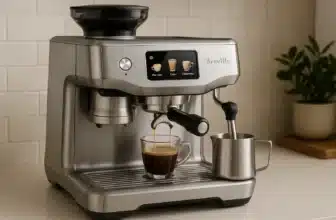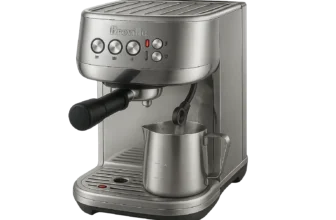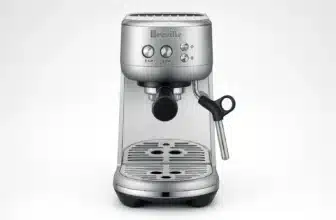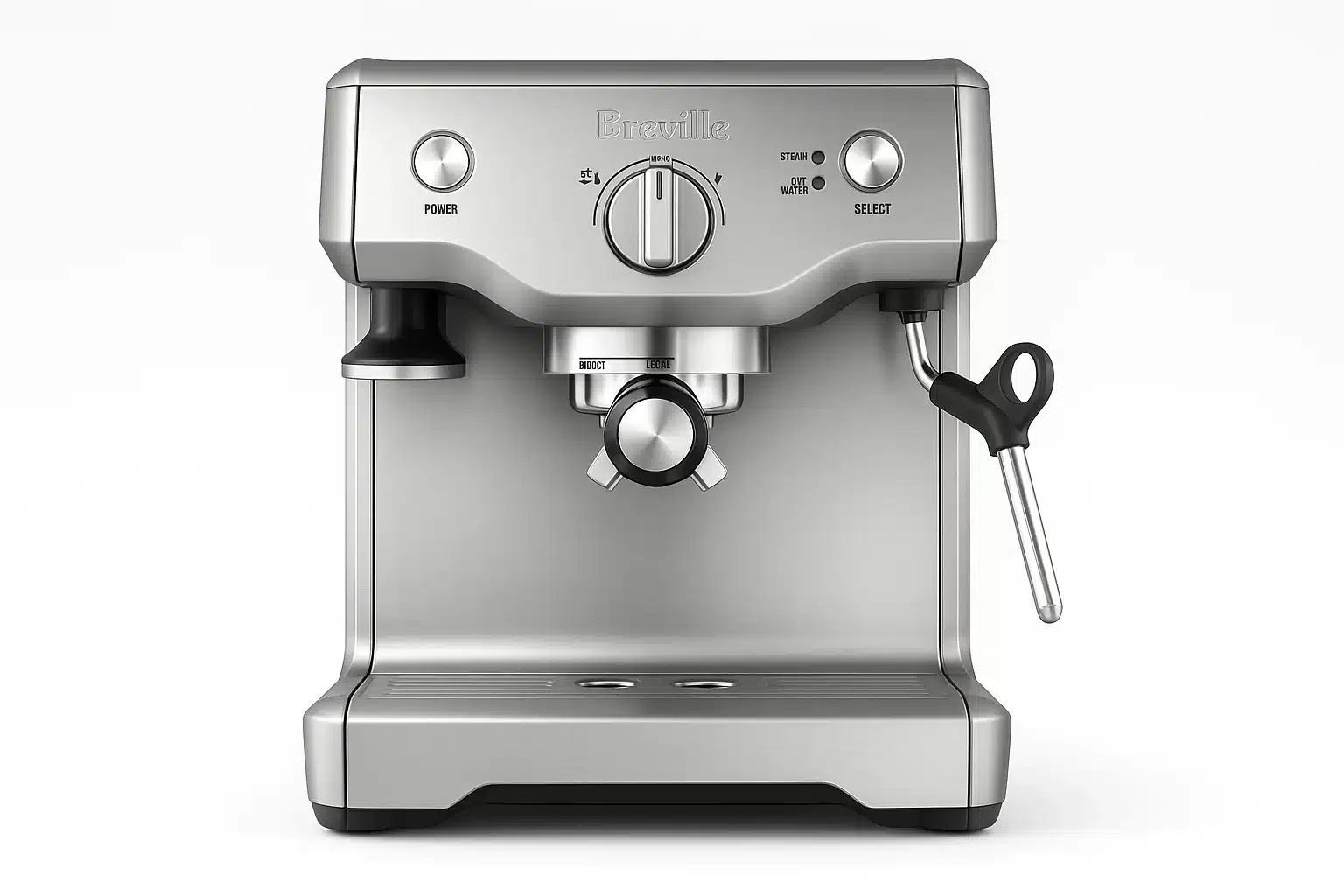
OneHundredCoffee is reader-supported, and some products displayed may earn us an affiliate commission. Details
If you’re chasing café-level espresso at home but don’t want a diva of a machine, the Breville Duo Temp Pro (BES810BSS) hits a sweet spot. It’s compact, handsome, and—when you respect its process—shockingly capable. I’ve been pulling shots on mine for months, tinkering with grind size and milk texture like it’s my quiet morning ritual. What surprised me most wasn’t a flashy touchscreen or auto programs (it has neither), but the way this straightforward machine teaches you good habits. It rewards consistency. It forgives a little. And it turns a sleepy kitchen into a small corner coffee bar without hogging the counter.
Here’s my long-form, hands-on take—what I love, what I learned, and how to get the most from this small but serious espresso partner.

Breville Dual Boiler Espresso Machine — Stainless Steel
Key Features
- Dual stainless-steel boilers for simultaneous extraction and steaming
- PID temperature control ensures consistent espresso shots
- Pre-infusion system for balanced flavor and rich crema
- 58mm commercial-grade portafilter for professional results
- LCD interface for shot timing and temperature programming
Why We Like It
The Breville Dual Boiler brings commercial-grade performance into home kitchens. Its precise temperature control, dual boilers, and effortless milk texturing make it a barista’s dream machine for café-level espresso at home.
Pros
Cons
- Requires routine descaling and maintenance
- Large footprint for smaller kitchens
Bottom Line
A professional-grade espresso machine designed for home baristas seeking precision, control, and true dual-boiler performance for seamless brewing and milk frothing.
Price on AmazonIntroduction: Why I Chose the Duo Temp Pro—and What Happened Next
I didn’t choose the Breville Duo Temp Pro for its fancy features. In fact, got it because I wanted control without the hassle. I wanted to experience the subtle differences between a good grind and a great one, to feel the moment the puck “accepts” water during pre-infusion, and to discover how a few seconds can alter sweetness. Plus, I wanted smooth, silky cappuccino foam on a Tuesday morning—without breaking the bank on a high-end setup.
The BES810BSS promised three specific things that mattered to me:
- Consistent temperature with low-pressure pre-infusion. I wanted predictable extraction without chasing overheated or underheated water.
- Manual control of shot length. No volumetric buttons here; I get to stop the shot when the stream blondes, not when a computer says “42 mL.”
- Proper steam power for microfoam. I drink flat whites and cappuccinos; if the wand can’t paint glossy milk, the deal’s off.
Within the first week, I’d dialed in a house espresso (medium roast, 1:2 ratio, ~30 seconds) that genuinely rivaled my local café. Not every shot was perfect—some days my grind drifted, other days my tamp was lazy—but the machine always met me halfway. When I did my part, the Breville did its part beautifully.
Here’s our detailed review.
Size & Design: Compact, Solid, and Quietly Confident
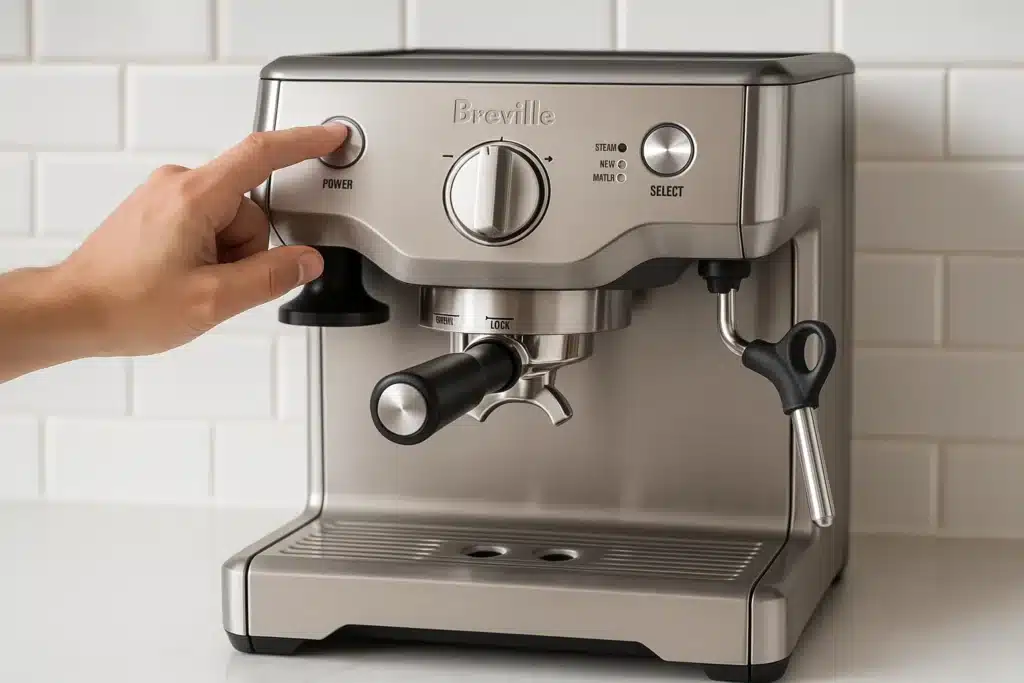
The Duo Temp Pro is a tactile win. The brushed stainless-steel body (the “BSS” in BES810BSS) feels durable and looks timeless among black toasters and chrome kettles. It’s not huge, and that’s important: on my narrow counter, it leaves space for a grinder, knock box, and a small scale.
- Footprint: Compact enough to live happily in a small kitchen. It sits deeper than a super-slim machine like the Dedica but shorter than a semi-pro box like the Silvia.
- Build feel: The portafilter locks in with a satisfying twist. The steam knob turns smoothly. Nothing rattles or feels flimsy.
- Workflow surface: The top warms cups gently. The drip tray slides out easily and includes a clever “Empty Me!” pop-up when it’s full.
Visually, it communicates the right message: “I’m serious, but I’m not scary.” No busy screens. No sensor forests. Just a clean fascia with an on/off, a steam control, and a brew toggle. The machine looks like it’s always ready to work—and it is.
A Brief Look at Our Top Breville Picks Under $500
| Image | Product | Features | Price |
|---|---|---|---|
Professional Dual Boiler Espresso  |
| Price on Amazon | |
Compact Barista-Quality Espresso  |
| Price on Amazon | |
 |
| Price on Amazon | |
Best Semi-Automatic Espresso Entry  |
| Price on Amazon |
Colors: Stainless First, Minimal Alternatives
In most markets, the Duo Temp Pro comes in brushed stainless steel. Breville sometimes releases alternative finishes in certain regions, but stainless is the default and, honestly, the most forgiving for fingerprints and daily use. If you’re color-coordinating a designer kitchen, note the limited palette—but also note how effortlessly the stainless pairs with matte black grinders and wood-handled tampers.
User Interface: One Switch, One Knob, and the Art of Paying Attention
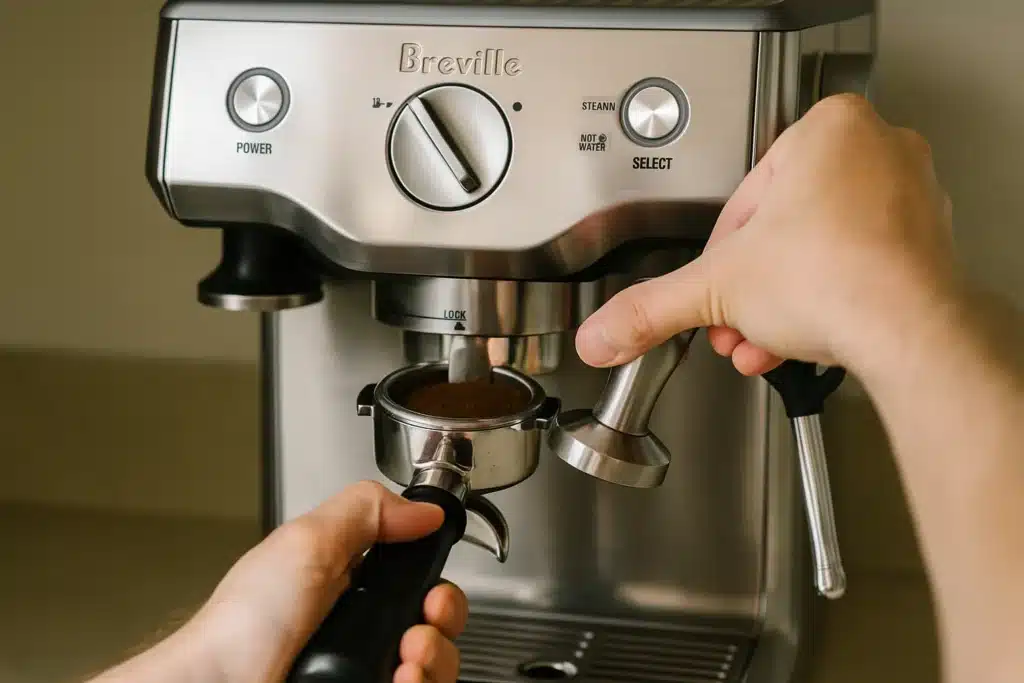
The UI is refreshingly minimal:
- Brew switch: Press to start water flow; press again to stop.
- Steam knob: Turn to steam; returning to center ends steaming and auto-purges to bring the thermocoil back to brewing temps.
- Indicators: Simple lights for ready states; no shot timer, no pressure gauge.
The lack of volumetric buttons is a feature, not a bug. I learned to watch the stream and listen to the pump. This made me better. I keep a small timer nearby; I start it when I flip the brew switch and stop it when the stream blondes or I hit my target output. After a few weeks, timing became instinct.
If you want a machine to make all the decisions for you, this isn’t it. If you want a machine that helps you learn and then gets out of your way, this absolutely is it.
Water Tank: Generous, Practical, and Easy to Live With
The tank sits at the back with a clear window, and the capacity is plenty for daily double shots and a couple of milk drinks before it needs refilling. I refill with filtered water (my tap is hard) to reduce scale and keep flavors clean. The tank lifts straight up for rinsing—something I do weekly. A clean tank, fresh water, and regular backflushing keep shots bright and machine internals happier.
Tip I learned the hard way: If you steam a lot of milk back-to-back, watch water levels more often. Steaming water faster than you think.
Built-In Grinder? Not Here—And That’s a Good Thing
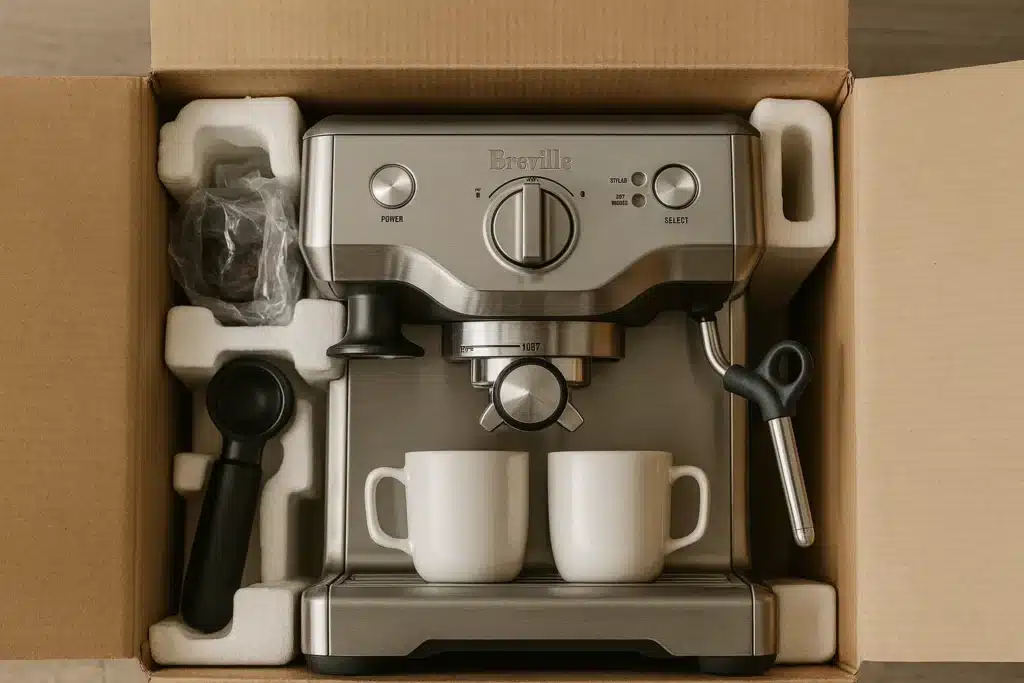
The Duo Temp Pro doesn’t include a grinder, which might sound like a downside. In reality, it’s a blessing: espresso quality lives and dies at the grinder. Pairing the machine with a good burr grinder gives you control over micrometric adjustments (the tiny changes that transform sour shots into sweet ones). I’ve used a mid-tier conical burr grinder with stepless adjustment, and the combination has been rock solid.
What to look for in a companion grinder:
- Consistent fine-range adjustments (especially for light/medium roasts).
- Low retention, so yesterday’s grounds don’t haunt today’s shot.
- Repeatability—a grind dial that means the same thing tomorrow as it did today.
Once I matched the Duo Temp Pro with a capable grinder, the machine’s potential opened right up.
Portafilter & Baskets: 54 mm, Real Espresso Tools, and a Helpful Razor
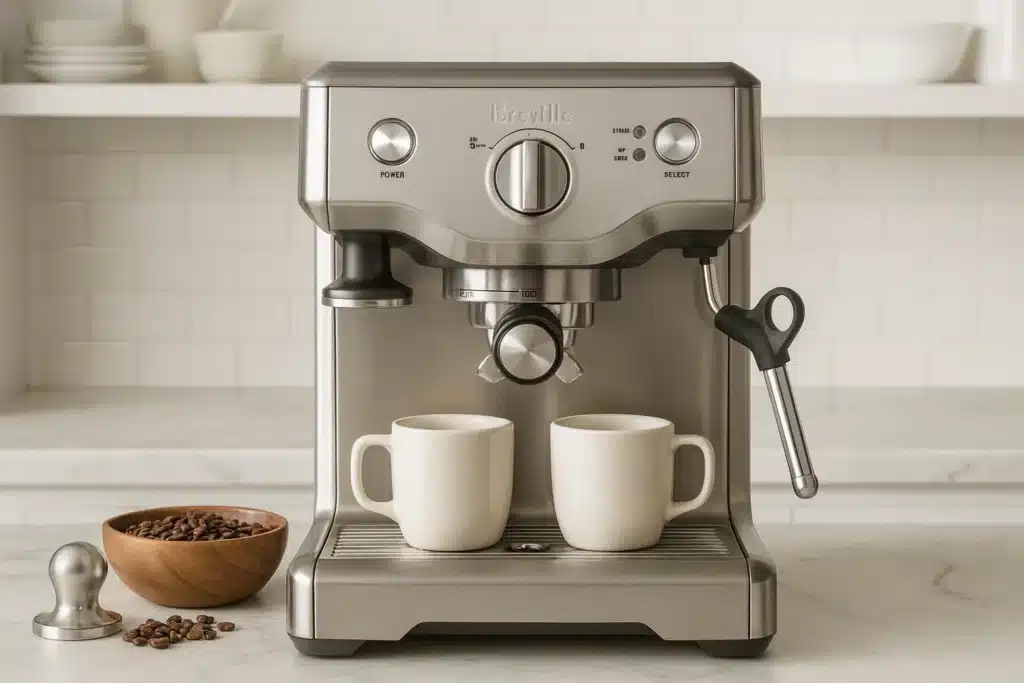
Breville ships a 54 mm portafilter—slightly smaller than the 58 mm standard on some prosumer machines, but it’s not a limitation. With dose and distribution dialed in, I get even, syrupy extractions.
Included baskets typically cover:
- Single-wall (non-pressurized) baskets for freshly ground coffee and full control.
- Dual-wall (pressurized) baskets if you’re using pre-ground coffee or an inconsistent grinder; they create artificial back pressure for a more forgiving shot.
Breville’s Razor dosing tool (my unsung hero) helps level the puck to a consistent height. I still WDT (Weiss Distribution Technique) with a thin needle tool to minimize clumps—especially on lighter roasts—and then tamp with a flat-base tamper. The difference in shot consistency was immediate when I added WDT to my routine.
Dosing: Manual Control That Teaches You to Taste
No programmable shot volumes here. You decide when the shot starts and ends. For my go-to espresso:
- Dose: 17–18 g in the basket
- Yield: ~34–36 g out
- Time: ~28–32 seconds from pump start
If I want a longer, more modern “espresso,” I’ll push to a 1:2.2 ratio; if I’m building milk drinks, I often stop closer to 1:1.8 for a thicker base. The key is taste first, numbers second. The machine gives you immediate feedback: tweak the grind a hair finer if it’s thin and sour; a hair coarser if it’s choked and bitter.
Pre-Infusion & Heating System: Gentle Start, Stable Extraction
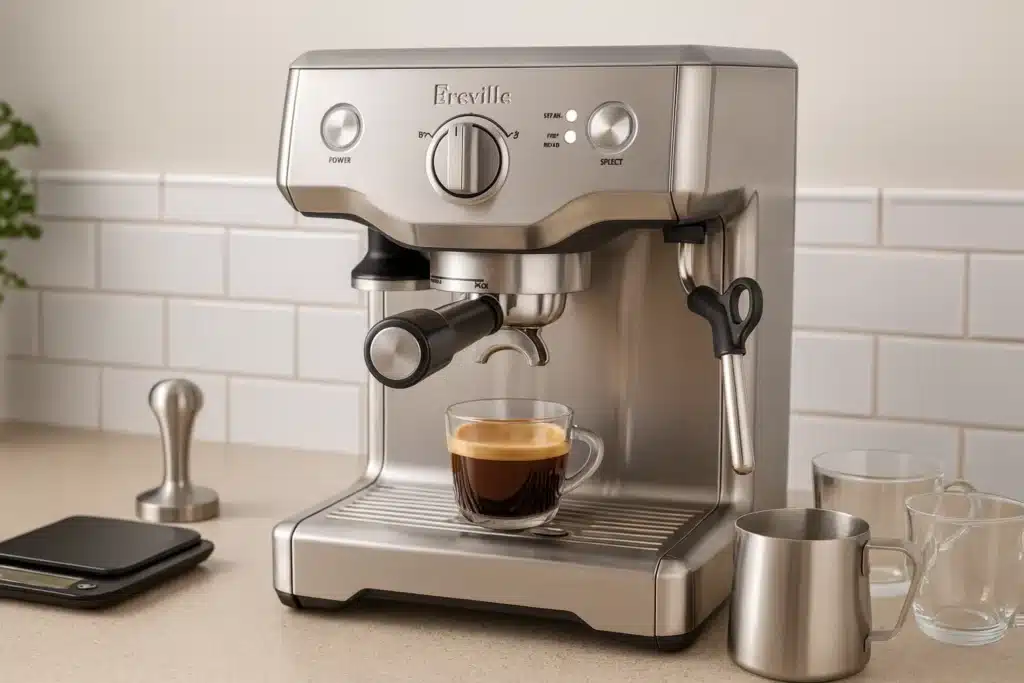
The “Duo Temp” name nods to the way this machine handles brew vs. steam temperatures, and it’s the pre-infusion that makes it sing. When you hit brew, the machine first soaks the puck at low pressure, helping seal micro-channels and equalize resistance before full pressure ramps up. In practice, this improves body and sweetness and reduces channeling—especially if your puck prep is solid.
After steaming, the auto-purge quickly cools the thermocoil back toward brew temps. It’s not instant, but it’s fast enough that my workflow rarely stalls. I purge a second or two of water through the group to settle temps before the next shot. That tiny habit keeps results repeatable.
Cup Size & Clearance: Enough Room, With a Little Dance
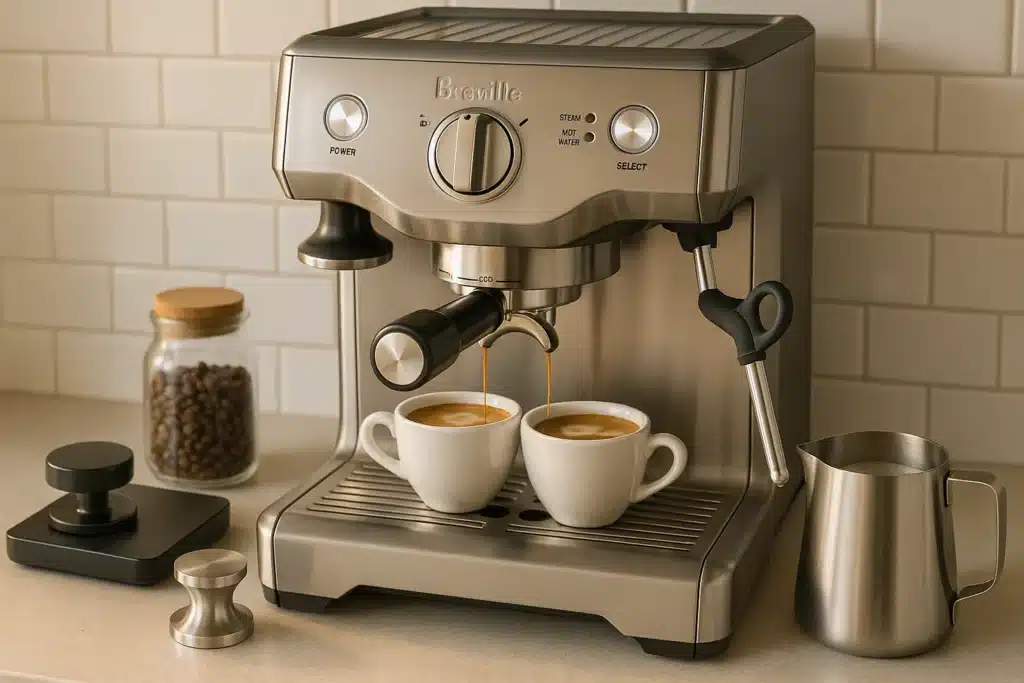
Cup clearance is adequate for standard espresso cups and small cappuccino cups under the portafilter. For taller glasses (like a 6–8 oz flat white glass), I either remove the drip tray grid or just pull into a short cup and top up with hot water or milk. It’s a familiar dance on compact machines; after a week, it’s second nature.
Pro move: pre-heat your cups on the top rail or with a quick hot-water rinse (I run a few seconds through the group). Espresso is tiny; cold porcelain steals heat fast.
Tamping: The Quiet Skill That Pays Dividends
The included tamper is decent; a 58 mm aftermarket tamper won’t fit, so if you upgrade, get one sized properly for Breville’s 54 mm baskets. My tamp ritual:
- WDT to break up clumps.
- Level the puck by tapping the side of the portafilter.
- Firm, level tamp—just enough to make the grounds a single, solid bed.
- A gentle polish turn.
Level beats force. The Duo Temp Pro’s pre-infusion helps a slightly imperfect tamp, but a level tamp is everything.
Temperature Control: Predictable, Repeatable, and Roast-Friendly
On a compact single-thermocoil machine, predictability is the real victory. The Duo Temp Pro doesn’t let me change brew temperature numerically, but it holds steady within the profile it’s designed to run. That translates to consistent flavor once my grind is right.
- Medium roasts: Sweet, balanced shots are easy.
- Light roasts: Still doable—go finer, consider a slightly longer ratio, and keep your pre-heat routine tight.
- Dark roasts: A breeze—watch your yield and stop early to avoid bitterness.
I treat the machine like a partner: I give it warm cups, a purged group, and fresh water; it gives me repeatable extractions. Fair trade.
Milk Frothing: Yes, You Can Make Glossy Microfoam
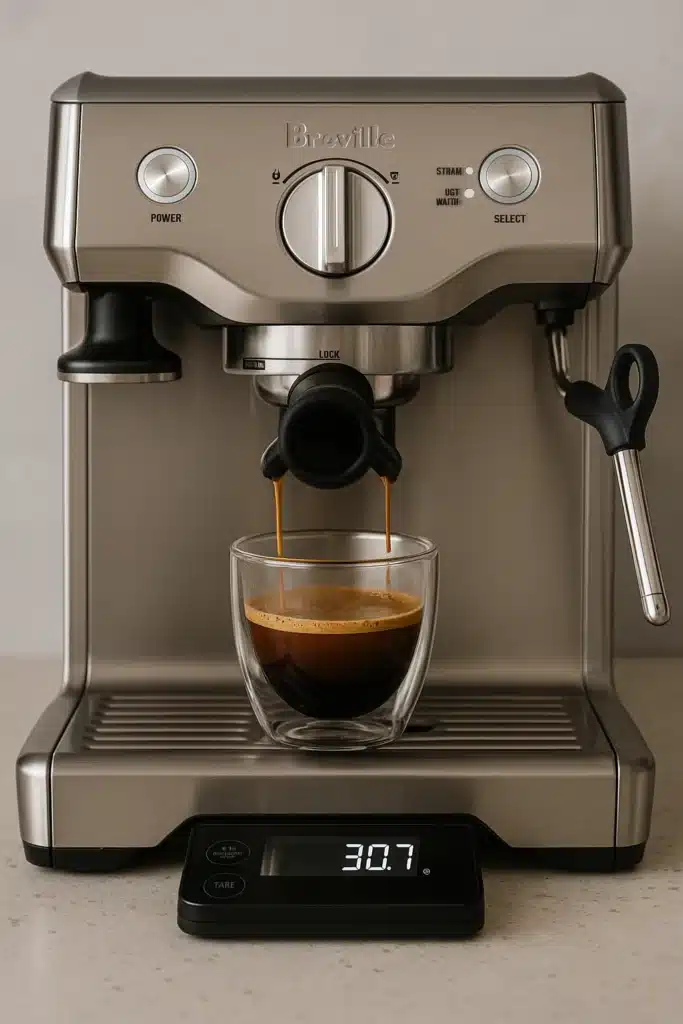
The steam wand has real bite. It’s not industrial-grade, but it’s more than capable of pouring silky latte art if you give it good milk and good pitcher control. My routine:
- Purge the wand for a second.
- Submerge the tip just under the surface to stretch the milk with a soft paper-tearing sound for a couple of seconds.
- Drop the pitcher slightly and roll the milk to polish.
- Stop steaming around 55–60°C (or when the pitcher is too hot to hold for more than a few seconds).
- Bang and swirl to pop microbubbles.
I consistently produce shiny, paint-like microfoam suitable for hearts, tulips, and the occasional rosetta when the espresso gods smile. If you’re new to steaming, this wand will teach you; it’s forgiving but honest.
Daily Workflow & Ritual: A 6–8 Minute Café at Home
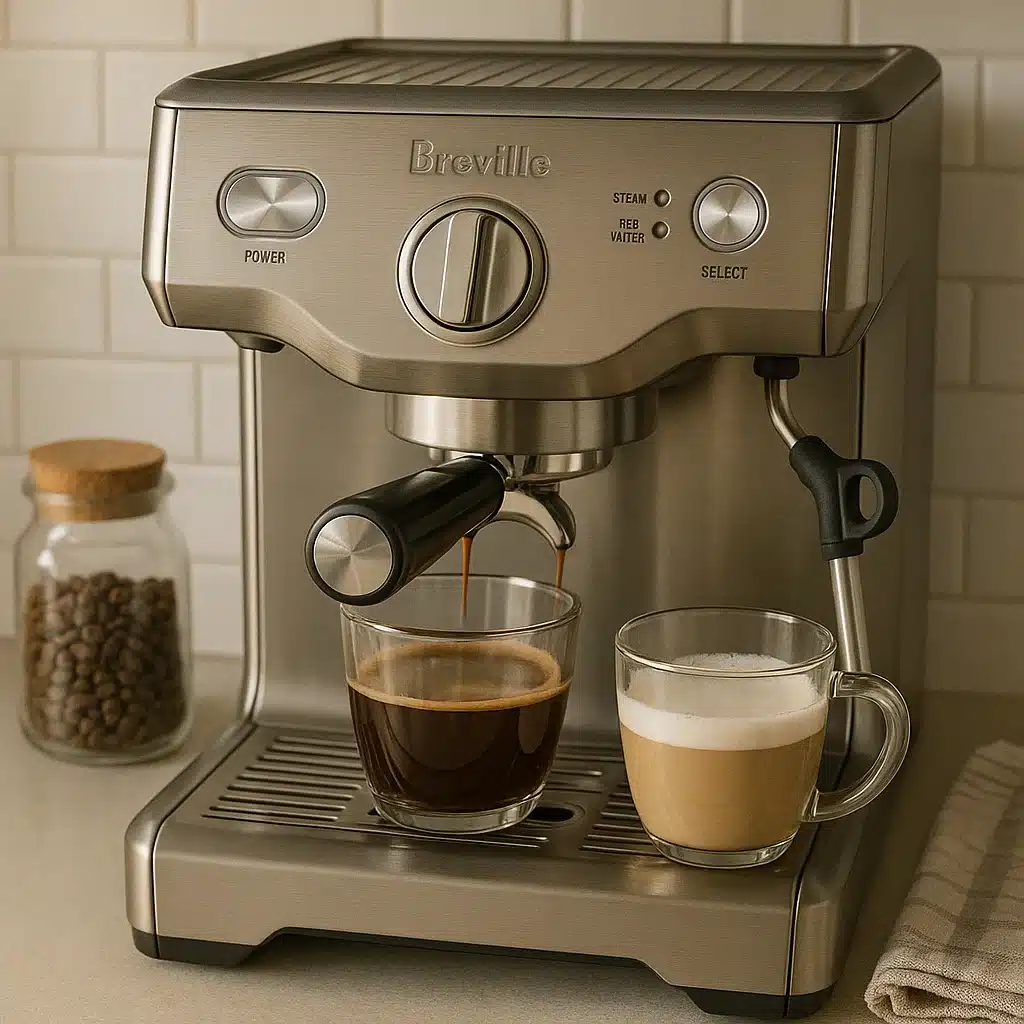
My morning routine:
- Warm-up & purge: Flip on the machine, prep my cup, run a second of water through the group.
- Grind & prep: Weigh 18 g, grind fresh, WDT, tamp.
- Pre-infuse & pull: Start brew, watch the first beads, ride the stream to my target output.
- Steam: Flip to steam, purge, stretch, roll, and polish.
- Clean: Rinse the portafilter, wipe the wand, and empty the puck into the knock box.
From start to first sip, it’s under 10 minutes—even with milk. On weekends, I slow down, experiment with different ratios, and pull back-to-back shots for friends. The machine keeps pace.
Cleaning & Maintenance: Simple Habits, Big Payoff
- After every shot: Knock out puck, quick rinse of portafilter and basket.
- After milk: Purge and wipe the wand immediately.
- Daily: Empty the drip tray if you’ve been busy. Wipe the body; stainless hides smudges but loves a quick polish.
- Weekly: Backflush with water. If your model supports a cleaning disk, use it with a cleaner tablet as directed.
- Monthly/Quarterly: Descale depending on water hardness (use filtered water to extend intervals).
These little habits keep the machine purring and the espresso tasting clean.
Taste & Espresso Quality: Sweet, Syrupy, Balanced
With a dialed-in grinder and decent beans, the Duo Temp Pro pulls sweet, round shots. It shines with classic espresso profiles (think chocolate, caramel, nuts) and handles modern fruity roasts if you’re patient with grind and yield. Crema is respectable; body is generous; clarity is good for a compact thermocoil machine. I often forget I’m on a sub-prosumer platform until I walk past a mirror and see my kitchen.
Learning Curve: Encouraging, Not Intimidating
The first week is exploration. By the second week, you’ll likely have your house recipe. The machine’s feedback is clear: if your shot runs too fast, go finer or increase the dose; if it chokes, go coarser or lower the dose. Because you’re manually stopping the shot, you develop a sense for blonding and flavor. It’s an espresso school, but the teacher is kind.
Who It’s For—and Who Should Look Elsewhere
Perfect for:
- New espresso enthusiasts who want to learn the craft instead of outsourcing decisions to automation.
- Milk-drink lovers who want real microfoam, not large-bubble fluff.
- Small kitchens that still dream big.
Maybe not for:
- People who need one-button automation and volumetric consistency.
- Households pulling five milk drinks back-to-back every morning (it can do it, but a bigger boiler will be faster).
- Tinkerers who absolutely require PID temp control and a 58 mm ecosystem—you might prefer stepping up in Breville’s line or to a prosumer machine.
Pros & Cons (From My Counter, Not a Spec Sheet)
Pros
- Low-pressure pre-infusion that meaningfully improves extractions
- Strong steam for creamy microfoam
- Compact, kitchen-friendly footprint and quiet confidence
- Manual shot control that teaches taste and technique
- Simple maintenance; auto-purge after steaming is a quality-of-life gem
Cons
- No built-in grinder (budget for a good one—it’s essential)
- No volumetric buttons or shot timer (you’ll use a scale/timer)
- A 54 mm ecosystem means fewer third-party accessories than a 58 mm
- Cup clearance is typical compact-machine fare (workarounds exist)
Comparison Table: How the Duo Temp Pro Stacks Up
| Machine | What You Feel Using It | Strengths | Trade-offs | Best For |
|---|---|---|---|---|
| Breville Duo Temp Pro (BES810BSS) | Manual, tactile, forgiving | Pre-infusion, strong steam, compact, affordable | No grinder, no volumetrics, 54 mm baskets | Learners who want real technique and milk drinks |
| Breville Infuser (BES840) | Similar vibe with more features | Pre-infusion + more temperature finesse, extra niceties | Slightly higher price, still no grinder | Users wanting a touch more control without going prosumer |
| Gaggia Classic Pro | Industrial feel, 58 mm ecosystem | Mod-friendly, durable, café-style portafilter | Enthusiasts are ready to manage temperature actively | Tinkerers who plan to mod and want 58 mm |
| De’Longhi Dedica Arte | Ultra-compact and fast | Tiny footprint, quick heat | Narrow baskets, less steaming power | Space-limited kitchens and beginners |
| Rancilio Silvia | Stout and serious | Great wand, 58 mm, longevity | Price, temp management skills required, slower workflow | Enthusiasts ready to manage temperature actively |
I chose the Duo Temp Pro because it gave me the most learning per dollar without sacrificing milk quality. If I ever “graduate,” it will be because I want a 58 mm platform—not because this machine held me back on taste.
Customer Guide: Getting Café-Quality from Day One
1) Buy a real grinder.
Put as much thought into the grinder as the machine. Espresso demands precision; an inconsistent grinder turns espresso into roulette.
2) Start with a simple recipe.
Try 18 g in, 36 g out, ~30 seconds. Taste. Adjust one variable at a time.
3) Respect pre-infusion.
Let the machine soak the puck; don’t rush. Watch for the first syrupy beads before full flow.
4) Master milk in two moves.
Stretch (two seconds of soft “paper tearing”), then roll (whirlpool to polish). Stop at ~60°C.
5) Build the habit stack.
Purge the group, warm the cup, wipe and purge the wand, backflush weekly, descale sensibly. This is how machines and flavors stay consistent.
6) Use a scale and a timer.
Numbers won’t replace taste, but they keep you honest and repeatable.
7) Choose beans wisely.
Freshly roasted within the past 3–4 weeks, stored airtight, ground just before brewing. Medium roasts are the easiest starting point.
8) Don’t chase perfection—chase progress.
The Duo Temp Pro rewards small improvements. Savor them.
Troubleshooting: What I Fixed and How
- Sour, thin shots (fast flow): Finer grind; check dose; tighten tamp; confirm pre-heat.
- Bitter, harsh shots (choked): Coarser grind; reduce dose; consider shorter ratio.
- Channeling (sprays or stripes): Improve distribution (WDT), ensure level tamp, use the Razor to standardize puck height.
- Milk big bubbles: Tip too high or stretching too long; lower the tip and shorten the stretch phase.
- Watery milk or no texture: Stop hotter and polish longer; purge the wand first; use whole milk to practice.
Every “issue” taught me a new mini-skill. Within a month, my notebook notes shrank from paragraphs to a few confident numbers and tasting words.
My Personal Experience & Opinion: What It’s Like to Live With
I wake up, grind, tamp, and start the pre-infusion. The first drip is always the best part—amber, thick, slow. I’ve learned the rhythm of the pump and the color that means, “okay, stop now.” If I’m in a cappuccino mood, the steam wand whispers and the milk turns into liquid satin. It’s not theater; it’s quiet competence.
The Duo Temp Pro made me fall in love with the process. It never pretends to be a café robot. It’s a partner that asks me to show up—measuring, tasting, adjusting—and then meets me with sweet, balanced espresso and silky milk when I do. That’s why it’s still on my counter long after the “new gear” glow faded.
If you want to grow into espresso without overwhelm, this machine is a keeper.
Frequently Asked (and Lived) Questions
Can I use pre-ground coffee?
You can with the dual-wall baskets, but you’ll miss the magic. Freshly ground beans are the difference between “okay” and “wow.”
Is warm-up time long?
It’s quick. I still pre-heat the portafilter and cup with a brief water run—worth the extra 30 seconds.
Can it handle light roasts?
Yes, with a precise grinder and patience. Go finer, push a slightly longer ratio, and pre-heat aggressively.
Does it make latte art–worthy milk?
Absolutely. The wand can produce glossy microfoam consistently once you learn the stretch-and-roll sequence.
Will I outgrow it?
Only if you catch the 58 mm or PID bug. Many never do—and keep loving the shots they pull on this machine.
Conclusion: Why the Duo Temp Pro Is Still My Daily Driver
The Breville Duo Temp Pro (BES810BSS) isn’t the most feature-packed machine on paper, and that’s precisely why it works. It offers real espresso fundamentals—stable heat, low-pressure pre-infusion, honest manual control, and a capable steam wand—wrapped in a compact, good-looking body. It taught me timing, grind discipline, and milk finesse without punishing me for being human.
Would a bigger boiler or PID add convenience? Sure. But for most home baristas, the Duo Temp Pro is the right kind of enough. It’s where craft and calm meet, every morning, in a small pool of crema at the bottom of your favorite cup.
If you’re ready to learn espresso the right way—with your senses, your hands, and a machine that respects both—this is a beautiful place to start and a satisfying place to stay.



